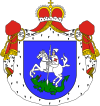Pahonia
| Pahonia | |
|---|---|
 |
|
| Versions | |

|
|

|
|
| Details | |
| Earlier versions |
 Grand Duchy of Lithuania |
| Use |
Belarus (1991–1995) Belarusian Democratic Republic (1918) |
The Pahonia (Belarusian: Паго́ня, transliteration: Pahonia, Belarusian pronunciation: [paˈɣonʲa]; Polish: Pogoń, Lithuanian: Vytis, literally: "Pursuer") was the coat of arms of the Grand Duchy of Lithuania, the Belarusian Democratic Republic in 1918 and of the Republic of Belarus from 1991 to 1995.
On May 14, 2007 Pahonia was declared cultural heritage of Belarus.
The charging knight first emerged as a state emblem in the region in 1329 on the seal of duke Alexander Michailovich of Pskov. He was deputy of Gediminas of Lithuania to Pskov which was a part of Grand Duchy of Lithuania at that time. At the same time duke Hlieb (Narimantas) of Polacak used Pahonia on his seal as well. These facts illustrate that it is the most probable that Pahonia was already in use as a state symbol of Lithuania at least in 1329. However, by Gustyn Chronicle duke Vytenis of Lithuania (1293–1316) "began ruling on Lithuania and designed a coat of arms and a seal for himself and for Lithuania: armed knight riding on horse; this symbol at present time is called Pahonia" (quote by "Chronicles about Pahonia's birth").
The symbol of the charging knight on horseback passed down through the generations: from Algirdas to his son, Grand Duke Jogaila (ruled 1377 – 1392), then to Grand Duke Vytautas (ruled 1392 – 1430) and to others. By the 14th century, the charging knight on horseback with a sword had begun to feature in an heraldic shield, first in Jogaila's's seal in 1386 or 1387, and also in the seal of Vytautas in 1401. As early as the 15th century, the heraldic charging knight on horseback became the coat of arms of the Grand Duchy of Lithuania and of its central part – the Duchy of Vilnius. 16th century documents refer to it using the Polish term Pogoń. At first, the charging knight might appear riding either left or right; and sometimes he held a lance. But as of the first half of the 15th century, all depictions show him riding towards the left (as seen by the viewer), with a sword in his raised hand and a shield in the left hand.
...
Wikipedia
